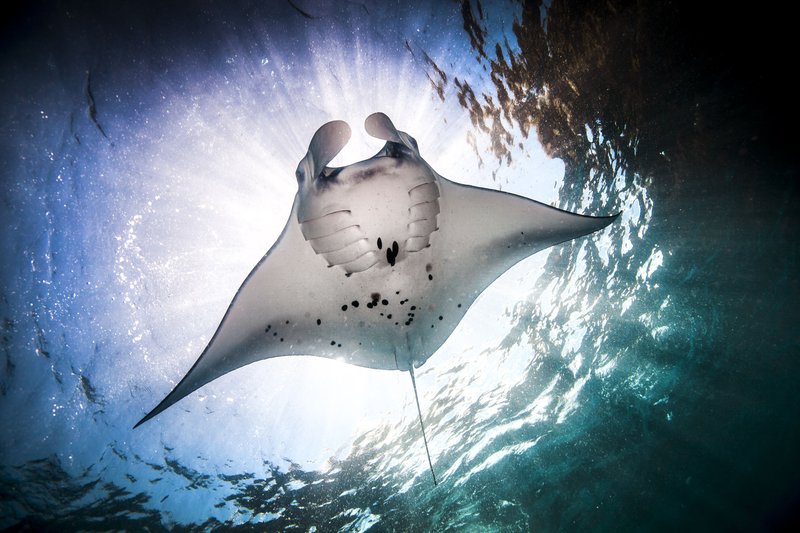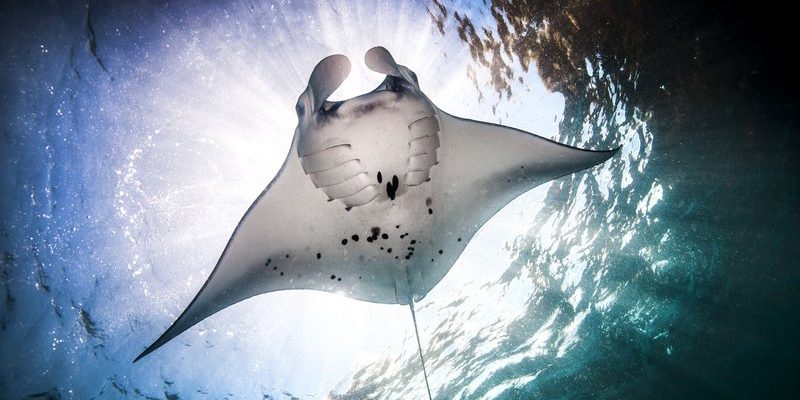
If you’ve ever been curious about these gentle giants, you’re in the right place. Whether you’re an aspiring marine biologist or just someone who appreciates the wonders of nature, getting to know manta rays can deepen your appreciation for marine life. Here are ten cool things you probably didn’t know about the manta ray that’ll make you look at them in a whole new light.
Manta Rays Are Enormous Creatures
One of the first things to know about manta rays is their impressive size. These magnificent animals can grow up to 20 feet wide! That’s like having a small car swimming gracefully in the ocean. Imagine swimming alongside something that big—it’s like a scene from a nature documentary right in front of you.
But what’s even more surprising is their weight. Manta rays can weigh as much as 3,000 pounds! Despite this massive size, they are surprisingly agile and can swim up to 15 miles per hour when they need to. When they glide through the water, you might think you’re watching a dancer in a performance, their bodies moving with fluid grace.
They’re Filter Feeders
You might be wondering what manta rays eat, especially considering their size. Here’s the thing: they are filter feeders! This means they eat tiny organisms, such as plankton and small fish, by filtering them out of the water. They open their mouths wide, and water flows in, allowing them to gulp up their food.
It’s somewhat similar to how a whale shark feeds, but manta rays have developed a unique way to feed. Their gills help filter out the food while letting the water flow back out. This method allows them to consume large amounts of food efficiently. Imagine sitting in a buffet line and being able to eat as much as you want without even trying—that’s what feeding time is like for manta rays!
They Have Unique Patterns
Did you know that each manta ray has a unique pattern on its belly? Just like our fingerprints, no two manta rays have the same markings. This distinctive feature helps researchers identify individual manta rays, showcasing their importance in biodiversity studies.
When researchers track these patterns, they gather valuable data to assist in conservation efforts. It’s not just about telling one ray from another; it’s about understanding their behavior, migration patterns, and overall health. These unique belly designs make manta rays not just beautiful but also essential for scientific discovery.
Manta Rays Can Live a Long Time
Manta rays are not just stunning and unique; they also have impressive lifespans. In the wild, they can live for more than 50 years! This longevity is fascinating, especially when you think about how much they can learn and thrive in their underwater environments.
You might be curious about what factors influence their lifespan. Like many creatures, manta rays face threats from pollution, fishing nets, and habitat loss. Understanding their life cycle can help conservationists create better strategies to protect these gentle giants for generations to come.
They’re Social Creatures
While manta rays might seem solitary at first glance, they are actually quite social! These creatures often form groups or “schools,” especially when it’s feeding time. Watching a group of manta rays swim together can be breathtaking. Picture them gliding smoothly through the water, their wings fluttering gently as they catch food.
Being social may also help them communicate with one another. Often, researchers have noted that certain behaviors—like swimming in close proximity—might indicate a form of interaction. Just like humans enjoy social gatherings, manta rays seem to appreciate the company of their fellow rays!
They Have a Unique Way of Breathing
Manta rays have a different breathing method compared to many other sea creatures. Instead of swimming continually like sharks to force water over their gills, manta rays can actually stop swimming and still breathe. They have a unique ability to pump water over their gills using a method called buccal pumping.
This technique allows them to conserve energy while still getting the oxygen they need. Imagine being able to take a break while running but still getting enough air—how cool is that? This unique feature is just another reason why manta rays are extraordinary.
Manta Rays Have a Weak Sense of Smell
You might think that being a creature of the ocean would give manta rays a super sense of smell, but here’s the catch: they actually have a weak sense of smell! While they can detect certain chemicals in the water, their reliance on vision and other senses is much stronger.
In fact, they rely heavily on their eyesight to hunt for food and navigate their surroundings. Picture trying to find a friend in a crowded room without being able to smell or hear them—it gives you an idea of how manta rays experience their world differently than other species.
They’re Not Dangerous
When many people think of rays, they might picture the stingrays with their barbed tails. However, manta rays are completely harmless. They don’t have stingers, and they’re known for their gentle nature. Most commonly, they’re observed swimming gracefully, often coming closer to divers and snorkelers out of curiosity.
If you ever find yourself in the presence of one, consider yourself lucky! Instead of fear, it’s an opportunity to appreciate the beauty of these wonderful creatures. Interactions between humans and manta rays have been known to lead to memorable experiences, emphasizing the importance of conserving their habitats.
Conservation Efforts Are Vital
Unfortunately, manta rays face various threats due to human activities, including overfishing, pollution, and climate change. Many countries are investing in conservation efforts to protect these magnificent creatures. For example, marine protected areas have been established in regions where manta rays are frequently spotted.
You might be wondering how you can help. Simple actions, like supporting sustainable fishing practices, participating in beach clean-ups, or even educating others about manta rays, can contribute positively to their conservation. It’s all about taking small steps to protect the incredible beauty of our oceans.
In conclusion, manta rays are truly remarkable animals with unique features that make them stand out in the marine world. From their impressive size and graceful movements to their gentle nature and the critical role they play in ocean ecosystems, manta rays are a prime example of nature’s wonders. Understanding these facts not only boosts our appreciation for them but also highlights the importance of protecting their habitats for generations to come. So next time you think about these gentle giants, remember all the cool things that make them special!

